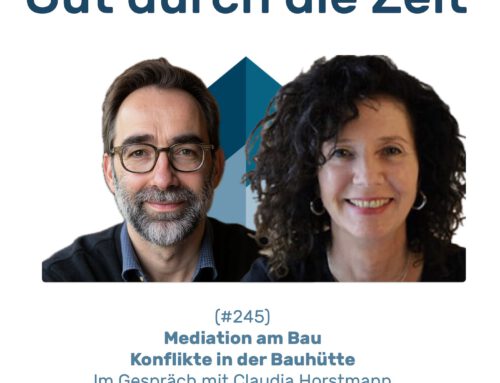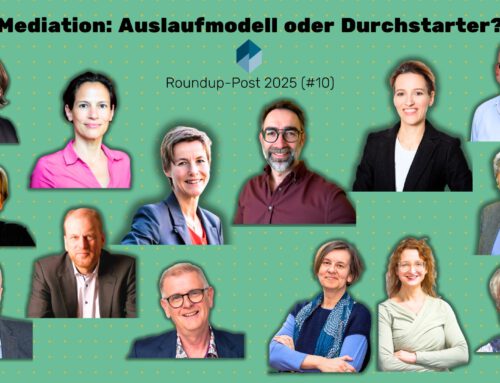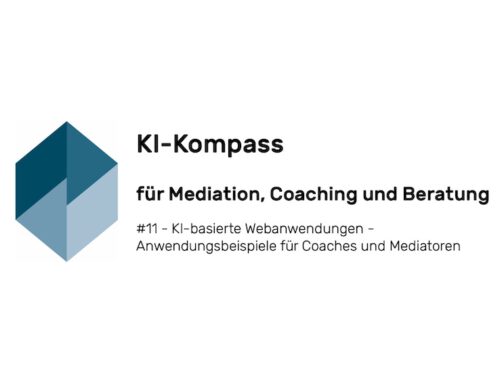INKOVEMA Podcast „Episodes of Mediation“
#17 EdM – Phases of Mediation II – The Clarification Phase
An orange is not the world – even if it's up to mischief in the minds of mediators
Episodes of mediation. The podcast on practical questions about mediation and conflict management.
Welcome to the EdM,
INKOVEMA's teaching stream on the practical issues of mediation and conflict management.
Practical situations in mediation, but also in coaching and conflict counselling, are explained, reflected upon and categorised.
This is episode 17 – Phases of Mediation II – The Clarification Phase.
CONTENTS
The following is about the second phase, the clarification phase, after I explained the contract phase in more detail in episode 14 and the creativity phase will be discussed in one of the next episodes.
What is the clarification phase about and what questions need to be answered in this phase – and how can the mediator help? This is what episode 17 will be about.
Introduction: Clarification phase
The clarification phase can – like the other phases – be completed in two stages:
STEP 1
The first step is for the parties to the conflict to visualise each other: What problems does party A face with party B? How did this come about from Party A's perspective? What does conflict party A need to address, discuss and clarify in mediation? And what role does Party B play in this? The key question is: What has happened from A's point of view and needs to be clarified, reconciled and changed that does not seem possible without B? And the same questions also apply to B – afterwards; whereby both parties have time and space to present their views and stories and questions should be asked sparingly, but above all not in a pressurising or persecutory manner. In short: Both sides present their own views and experiences in detail; put the other person in their own picture – and the other person's only task in these moments is to listen carefully and try to understand how A has experienced, remembers and describes their situation. Because this is the basis for the conflict experience. And this is then made possible in a mirror image for B, whereby A listens, understands and
STEP 2
The second step is to shed light on the conflict relationship. This The conflict relationship consists primarily of these two different, personal perspectives. Each party to the conflict defines the situation (=conflict) as problematic in its own way and also has solutions at the ready, which are usually communicated in an escalating manner. These solutions lead to escalationbecause they come across as one-sided, uncoordinated, but claiming the other.
These unsolicited, uncoordinated approaches to solutions
are the crystallisation points of escalation.
These solutions have to be fended off, which can be observed as escalation. This is why conflict parties experience themselves as reactors in the conflict, hardly ever as actors: Conflict parties defend themselves against the interpretations and claims of the other conflict parties. This is why conflict opponents always appear as deniers (with regard to their own solution approaches!) and as escalators (with regard to their own solution ideas). This is why the second step in the clarification phase is primarily a phase of illumination as a result of deceleration and self-reflection. Not only with regard to the motives and unknown actions of others, but at best also when one's own effects are recognised. Nevertheless, it must be emphasised here that conflicts are by no means always mere misunderstandings and that mediation would be successful if the misunderstandings were cleared up and everyone was united and agreed. This is by no means the case.
Two aspects generally have a clarifying effect
The communicated and barely agreed solution approaches of the conflict parties – e.g. the "Shut up! And stop it!" or "Do it at last, you're obliged to!", which is one of the party's ideas for a solution that does not meet with approval, but instead meets with resolute opposition. In a conflict, resistance is not only experienced inwardly, but also socially and thus communicatively revitalised. The "no" is stated loudly and actively, which is now assessed as a problem or conflict. In reality, however, the communicated "no" is a solution approach to the other side's solution approach. The communicated no is at the same time a communicated, non-agreed, one-sided solution that is to be accepted, i.e. affirmed. Systems theorists recognise the communication system of conflict here, while mediators recognise the exchange of POSITIONS. The underlying idea, the motivation, the interest being pursued, the desired goal is initially and generally not communicated. But in the clarification phase, these positions are scrutinised by the mediator: what INTERESTS AND NEEDS go hand in hand with them. These should now become visible and audible in the mediation. The underlying idea and theory of mediators is that this creates one-sided negotiation masses, which together grow into negotiation spaces for the conflict parties, which in turn enable completely new approaches to solutions. Sometimes this not only sounds like theory, but is also sometimes transferred into practice by mediators as a compelling logic that this approach automatically leads to solutions. In reality, however, this is not the case. There are worlds between theory and clever ideas and a logic that can be practised and experienced. Or metaphorically for insiders: an orange is not the world – even if it is up to mischief in the minds of mediators.
Work objectives in the clarification phase
What are the important content-related work objectives in the clarification phase?
FIRST deceleration, SECOND disappointment, THIRD relaxation **.
- Decelerate means that the bombardment with unagreed solution ideas is benevolently interrupted.
- Disappoint means that the solution is not one-sided after all, but can now be enforced with the help of the mediator. The other party will actually not only have a say, but a say in the conflict resolution.
- Relax This means that the common playing field is once again perceived as a potential solution field in all its splendour and size and the tight grip on the first solution idea can be loosened.
If you want to build bridges, you have to clearly visualise the distances to be overcome.
Important working methods:
Mirroring, paraphrasing, looping, i.e. ensuring understanding; visualising in order to recognise the problem areas as common fields of play, conflict and solution and to be able to make them usable.
A word about the search processwhich the third person should initiate and moderate. The DIFFERENCE LINES of the conflict parties should be focussed on, not the spots of agreement and islands of harmony! What this means cannot be understood without the basic strategic approaches of mediators.
- It is possible to work in such a way that the islands of harmony of the escalated conflict parties are focussed on in order to build bridges from there and to negotiate the common future and the associated next steps. In this case, mediators would look for common ground and agree on joint steps on the basis of shared interests and needs, which may of course also diverge (separation in unity, albeit with great regret that the common ground does not lead to common ground).
- Another strategy is to address the lines of difference in mediation. What divides? Where do the parties disagree? Where and how do their different assessments clash? Is it in the definition of the problem, is it in the attribution of the significance of the problem or its possible solutions or the need for solutions? The parties to the conflict should therefore start by naming or recognising their differences and the mediators should not emphasise and underline what they have in common too early, want to hold on to it and declare it as an anchor of common ground. Harmony is not needed in excess during the clarification phase. Because these lines of difference are important to emphasise and reveal. The parties verbalise their positions and perspectives, are instructed and questioned precisely on how to position themselves and fully perceive and accept this difference as a common starting point. There is no need for team members, managing directors, married couples or other communities of conflict to make the often erroneous assumption that they are basically in agreement, want the same thing and are not far apart. Wait a minute! Yes, you should fearlessly name your differences. Because that is the starting point for the entire conflict management process. Only when this distance has been properly measured can the intended bridge-building succeed. Both sides need to clarify for themselves and with each other where they currently stand and whether they want to build new bridges, how these could be built and to what extent the consequences of solidarity are actually desirable. Focussing on these lines of difference and conflict represents an enormous amount of work for the mediator, who is usually dealing with conflict parties who are eager for harmony and agreement and who want to get out of the mediation setting, the incarnate declaration of disagreement, as quickly as possible. Methodologically, however, it is necessary to define the common line of difference with which all parties can identify.
Important work results:
An agenda that defines the lines of difference in a way that is acceptable on all sides, as well as a willingness to compromise or move away from the communicated positions and follow the interests that can also be fulfilled differently. Whichever way you look at it, mediation requires conflict parties who are prepared to abandon their positions, who are willing to compromise in principle and who sit down at a table to do so. In this respect, the theory that there is an interest behind every position, if necessary an invisible interest that is difficult to recognise but can be discovered, is clearly taken from the age of psychology, a child of this great phase of psychologisation and a very practical trick used by mediators to create a willingness to negotiate or to demand it in relation to the mediator and to communicate it to the parties to the conflict.
Other important working methods:
ding questions, offering hypotheses, visualising and simply being present as a neutral, impartial, benevolent third party, which in itself is already a cause and expression of social pressure.
So anyone who, as a mediator, manages not to be expelled from the negotiating table and the room by the parties to the conflict is very likely to witness a final agreement. The entire work programme of mediators could also be summed up as follows: If you've been hired and committed to being a mediator, your only job is to not get kicked out while you're giving the parties unpleasant things to talk about.
That’s it for this time, thank you very much for listening, and perhaps you were able to develop one or two ideas for one of your cases, take them further and make decisions. I wish you every success!
If you would like to support this podcast, please leave feedback on Apple Podcast or on Google Business.




Leave A Comment